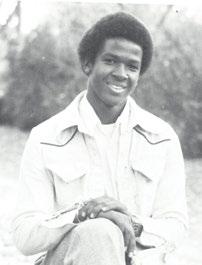
6 minute read
The Wasp’s Nest
The Wasp’s Nest
BY FRED NORGAARD '71
Advertisement

Note: For the full version of this article, visit www.kentdenver.org/perspective
Just days into the fall 1968 semester, stacks of a five page, letter size, stapled, crudely typed and mimeographed document titled The Wasp’s Nest were left at both DCD and Kent.

There were two poems, one entitled “Prague West,” about the police beatings at the 1968 Chicago convention. There was an invitation to “ADB” to write an article. There was a contact address listed as S.W.I.N.E (Students Wildly Indignant About Nearly Everything), General Delivery, Littleton Post Office. The paper was confiscated.
“Last summer at the conclave of headmasters, I learned that unless a school had an underground newspaper it was simply not “in”. Well, we’re in. See the enclosed, which appeared here today and was also distributed at Kent. (There is some evidence that Kent girls were involved in the production of the sheet, but I prefer to operate on the assumption that it is a DCD show.) I believe it would be a mistake to create a loud administrative flap over this matter.” - Andy Black, DCD Head of School (1953–1972)
Soon, however, a second edition of The Wasp’s Nest came out under the headline “Entire First Issue Confiscated.” It included “An Open Letter to the Trustees” laying out student requests: “All DCD students know what the trustees are. They are misty demi-gods, who, from their seats in faraway Valhalla, dictate, in some vague way, the workings of the school. The average trustee has about as obscure an impression of the average seventh grader as the average student has of the trustee. Why not not do something about this obscurity? The editors of The Wasp’s Nest would be very happy to meet with any trustee who would like to meet with us. And we have it on good authority that the Student Council would likewise be so willing.”
The paper was confiscated again.
The third edition of The Wasp’s Nest started with the headline “The Underground Surfaces.” After the paper’s second confiscation, it reported, a “treaty” was struck with Mr. Black. “In return for disclosing our names, we have at our disposal all the printing facilities provided by DCD and Associated Schools, our paper was returned and we were granted privileges. We won.”

This edition of the paper was the first to have a masthead. There were four DCD editors, three seniors, one junior, and seven staff members, including two Kent girls.
The DCD Board of Trustees also decided to accept the invitation by The Wasp’s Nest editors to meet with students, who presented suggestions for the improvement of the School.
“The Student Council requested that the Trustees give highest priority to improving the faculty salary scale, saying that to do so would be an investment in the School’s long range excellence… The scholarship program, particularly aid for economically and culturally deprived inner-city boys, should be increased…” - DCD Board of Trustees meeting minutes, December 8, 1968
Just five months later, minutes from the May 1969 Board meeting noted: “At the request of President Duke [DCD Board of Trustees President H. Benjamin Duke, Jr.], the Headmaster reported to the Student Council the substance of steps taken to fulfill their requests of December 1968 for the betterment of the school … a six percent increase in faculty salaries for the coming year; the active recruitment of minority and disadvantaged students to expand the scholarship program; an improvement in the food served at the School; and a full scale review of the School’s athletic policy would be undertaken in the summer.”

The final edition of The Wasp’s Nest was devoted mostly to racial issues and antiwar sentiments. There was a long piece on the black power movement. There was also a political cartoon and a call for the formation of a literary magazine, since Colorado Academy had one and DCD did not.
The Wasp’s Nest didn’t last past 1969, but the waves it made kept rippling out during the rest of the school year and beyond.

Charlie Emmons '74 (above) (now deceased) and Capt. William Eric Mosley '77 (below) were two of the early integrators at DCD/KDCD following student activism for greater diversity. In a 2006 article in Denver’s CORE magazine, Emmons interviewed Mosley about the difficulties and challenges they faced as some of the school’s first Black students, as well as the growth they experienced:

“Despite the difficulties and challenges, I was able to find my stride and confidence and grew into who I am as a person,” said Kent Denver Distinguished Alumni Award recipient Mosley. “I became confident and comfortable in my own skin.”
In a 2022 interview for the school’s Centennial yearbook, Mosley added that DCD/KDCD faculty member Walter S. Rosenberry III offered invaluable encouragement “to defy the odds and to live up to the high standards embodied by my parents.”
Mosley’s mother, Edna, was a civil rights leader, business woman and the first Black city councilwoman in Aurora, CO. His father, Lieutenant Colonel John Mosley, was a community leader, inductee to Colorado’s Sports Hall Of Fame, combat pilot and member of the Tuskegee Airmen.
Given his family legacy and his time at the school, it’s not surprising Mosley’s senior yearbook quote was “Self-Confidence: The first secret of success. - Ralph Waldo Emerson"

The Kent School admitted its first Black student—second grader Melanee Porter—for the 1964–1965 school year. Melanee served on the Lower School Council that year, but did not return to the school for third grade. Kent’s archival records do not provide any details about her experiences as the first and only Black student to attend Kent in the mid-1960s.






